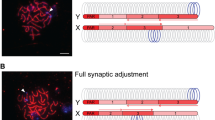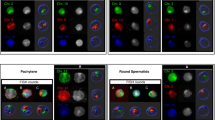Abstract
Multiple configurations involving the L 3 and L 4 homologues have been observed in all individuals from a population sample of Metrioptera brachyptera. These associations which persist up to and including metaphase of the first meiotic division are non-homologous and achiasmate in character. They are conditioned by the persistent association of large distally located heterochromatic blocks on the L 3 and L 4 chromosomes and are not, as White has proposed, the result of crossing over in translocated terminal duplications. When the L 3 and L 4 chromosomes form bivalents the distal heterochromatin restricts crossing over in this region and chiasmata are localised proximally. In other members of the complement chiasmata are localised at either or both the centric and telomeric ends. A relationship is demonstrated between the pattern of chiasma localisation and that of chromosome pairing.
Similar content being viewed by others
References
Coleman, L. C.: The relation of chromocenters to the differential segments in Rhoeo discolor. Amer. J. Bot. 28, 742–748 (1941).
Darlington, C. D.: The internal mechanics of the chromosomes II. Relational coiling and crossing over in Fritillaria. Proc. roy. Soc. B 87, 74–96 (1935).
John, B., and S. A. Henderson: Asynapsis and polyploidy in Schistocera paranensis. Chromosoma (Berl.) 13, 111–147 (1962).
—, and G. M. Hewitt: Karyotype stability and DNA variability in the Acrididae. Chromosoma (Berl.) 20, 155–172 (1967).
—, and K. R. Lewis: Genetic speciation in the grasshopper Eyprepocnemis plorans. Chromosoma (Berl.) 16, 308–344 (1965a); - The meiotic system. Protoplasmatologia VI/F/1. Wien: Springer 1965 (b).
Koul, A. K.: Heterochromatin and non-homologous chromosome association in Coix aquatica. Chromosoma (Berl.) 15, 243–245 (1964).
Li, N., and R. C. Jackson: Cytology of supernumerary chromosomes in Haplopappus spinulosus ssp. cotula. Amer. J. Bot 48, 419–426 (1961).
Marquardt, H.: Die Meiosis von Oenothera I. Z. Zellforsch. 27, 159–210 (1938).
White, M. J. D.: Chiasma localisation in Mecostethus grossus and Metrioptera brachyptera. Z. Zellforsch. 24, 128–137 (1936); - A translocation in a wild population of grasshoppers. J. Hered. 3, 137–140 (1940b); - Animal cytology and evolution, 2nd. edit. Cambridge: Univ. Press 1954; - Cytogenetics of the grasshopper Moraba scurra I. Meiosis of interracial and interpopulation hybrids. Aust. J. Zool. 5, 285–304 (1957); - The role of chromosomal translocation in urodele evolution and speciation in the light of the work on grasshoppers. Amer. Naturalist 95, 315–321 (1961).
Author information
Authors and Affiliations
Rights and permissions
About this article
Cite this article
Southern, D.I. Pseudo-multiple formation as a consequence of prolonged non-homologous chromosome association in Metrioptera brachyptera. Chromosoma 21, 272–284 (1967). https://doi.org/10.1007/BF00329551
Received:
Issue Date:
DOI: https://doi.org/10.1007/BF00329551




